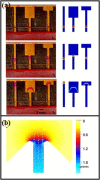A review on wax printed microfluidic paper-based devices for international health
- PMID: 28936274
- PMCID: PMC5577007
- DOI: 10.1063/1.4991504
A review on wax printed microfluidic paper-based devices for international health
Abstract
Paper-based microfluidics has attracted attention for the last ten years due to its advantages such as low sample volume requirement, ease of use, portability, high sensitivity, and no necessity to well-equipped laboratory equipment and well-trained manpower. These characteristics have made paper platforms a promising alternative for a variety of applications such as clinical diagnosis and quantitative analysis of chemical and biological substances. Among the wide range of fabrication methods for microfluidic paper-based analytical devices (μPADs), the wax printing method is suitable for high throughput production and requires only a commercial printer and a heating source to fabricate complex two or three-dimensional structures for multipurpose systems. μPADs can be used by anyone for in situ diagnosis and analysis; therefore, wax printed μPADs are promising especially in resource limited environments where people cannot get sensitive and fast diagnosis of their serious health problems and where food, water, and related products are not able to be screened for toxic elements. This review paper is focused on the applications of paper-based microfluidic devices fabricated by the wax printing technique and used for international health. Besides presenting the current limitations and advantages, the future directions of this technology including the commercial aspects are discussed. As a conclusion, the wax printing technology continues to overcome the current limitations and to be one of the promising fabrication techniques. In the near future, with the increase of the current interest of the industrial companies on the paper-based technology, the wax-printed paper-based platforms are expected to take place especially in the healthcare industry.
Figures






Similar articles
-
Single step and mask-free 3D wax printing of microfluidic paper-based analytical devices for glucose and nitrite assays.Talanta. 2019 Mar 1;194:837-845. doi: 10.1016/j.talanta.2018.10.104. Epub 2018 Nov 2. Talanta. 2019. PMID: 30609613
-
Fabrication of paper-based microfluidic devices using a 3D printer and a commercially-available wax filament.Talanta Open. 2022 Dec;6:100142. doi: 10.1016/j.talo.2022.100142. Epub 2022 Aug 28. Talanta Open. 2022. PMID: 36093430 Free PMC article.
-
Beyond Wax Printing: Fabrication of Paper-Based Microfluidic Devices Using a Thermal Transfer Printer.Anal Chem. 2022 Jun 28;94(25):8833-8837. doi: 10.1021/acs.analchem.2c01534. Epub 2022 Jun 13. Anal Chem. 2022. PMID: 35694851
-
Recent Advances In the development of enzymatic paper-based microfluidic biosensors.Biosens Bioelectron. 2023 Apr 15;226:115131. doi: 10.1016/j.bios.2023.115131. Epub 2023 Feb 6. Biosens Bioelectron. 2023. PMID: 36804663 Review.
-
Electrochemical microfluidic paper-based analytical devices for cancer biomarker detection: From 2D to 3D sensing systems.Talanta. 2023 May 15;257:124370. doi: 10.1016/j.talanta.2023.124370. Epub 2023 Feb 16. Talanta. 2023. PMID: 36858013 Review.
Cited by
-
Fabricating Paper Based Devices Using Correction Pens.Sci Rep. 2019 Feb 11;9(1):1752. doi: 10.1038/s41598-018-38308-6. Sci Rep. 2019. PMID: 30741986 Free PMC article.
-
Recent Advances in Microfluidic Paper-Based Analytical Devices toward High-Throughput Screening.Molecules. 2020 Jun 28;25(13):2970. doi: 10.3390/molecules25132970. Molecules. 2020. PMID: 32605281 Free PMC article. Review.
-
Biomarker Detection in Early Diagnosis of Cancer: Recent Achievements in Point-of-Care Devices Based on Paper Microfluidics.Biosensors (Basel). 2023 Mar 15;13(3):387. doi: 10.3390/bios13030387. Biosensors (Basel). 2023. PMID: 36979600 Free PMC article. Review.
-
Multifolding Vertical-Flow Electrochemical Paper-Based Devices with Tunable Dual Preconcentration for Enhanced Multiplexed Assays of Heavy Metals.Anal Chem. 2025 Jan 21;97(2):1457-1464. doi: 10.1021/acs.analchem.4c06982. Epub 2025 Jan 9. Anal Chem. 2025. PMID: 39783778 Free PMC article.
-
Addressing cervical cancer screening disparities through advances in artificial intelligence and nanotechnologies for cellular profiling.Biophys Rev (Melville). 2021 Mar;2(1):011303. doi: 10.1063/5.0043089. Biophys Rev (Melville). 2021. PMID: 33842926 Free PMC article. Review.
References
-
- Voswinckel P., Kidney Int. Suppl. 47, S3 (1994). - PubMed
-
- Feigl F., Anal. Chem. 27, 1315 (1955).10.1021/ac60104a031 - DOI
-
- Free A. H., Adams E. C., Lou Kercher M., Free H. M., and Cook M. H., Clin. Chem. 3, 163 (1957). - PubMed
-
- Liu B., Du D., Hua X., Yu X.-Y., and Lin Y., Electroanalysis 26, 1214 (2014).10.1002/elan.201400036 - DOI
Publication types
LinkOut - more resources
Full Text Sources
Other Literature Sources
Research Materials
